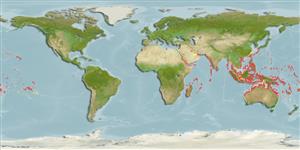Common names from other countries
>
Eupercaria/misc (Various families in series Eupercaria) >
Labridae (Wrasses) > Corinae
Etymology: Halichoeres: Greek, als, alis = salt + Greek, choiros = pig (Ref. 45335).
More on author: Rüppell.
Environment: milieu / climate zone / depth range / distribution range
นิเวศวิทยา
เกี่ยวกับทะเล,น้ำเค็ม เกี่ยวกับหินโสโครก; ระดับความลึก 0 - 30 m (Ref. 1602). Tropical; 31°N - 33°S, 33°E - 124°W
Indo-Pacific: Red Sea south to Inhaca Island, Mozambique (Ref. 4392) and east to the Hawaiian (1 specimen) and Tuamoto islands, north to southern Japan, south to the southern Great Barrier Reef and Austral Islands.
Length at first maturity / ขนาด / น้ำหนัก / Age
Maturity: Lm 7.0 range ? - ? cm
Max length : 18.0 cm TL เพศผู้/กระเทย; (Ref. 4392)
Short description
เครื่องมือที่ใช้ในการแยกชนิดสัตว์,สิ่งมีชีวิตออกจากกัน | สัณฐานวิทยา | ความยาวต่างๆ
เงี่ยงครีบหลัง (รวม) : 9; ก้านครีบอ่อนที่หาง (รวม) : 13 - 14; เงี่ยงครีบก้น: 3; ก้านครีบอ่อนที่ก้น: 12 - 13. Juveniles are black with numerous longitudinal white streaks (Ref. 1602).
Inhabit lagoon and seaward reefs, along the upper edges of coral-rich areas (Ref. 9710, 58534). Benthopelagic (Ref. 58302). May be solitary or found in small group (Ref. 90102). Juveniles are encountered in exposed outer reef flats (Ref. 1602). Feed on a wide variety of small invertebrates as well as fish eggs.
Pelagic spawner. Females migrate to spawning sites, larger females travel long distances to downcurrent areas than smaller ones to protect the eggs from becoming prey to larger reef fishes (Ref. 32198). Spawning sites are chosen by the females irregardless of the males occupying them (Ref. 32198). Females spawn in more than one spawning site, each site occupied by more than one male, which are either territorial or non-territorial (Ref. 32198). After spawning, they return individually to their home ranges without passing through other spawning sites (Ref. 32198). Some females on the other hand change sex after spawning (Ref. 32198). As males, they begin to establish territories in the spawning sites, even to those they visited before the sex change (Ref. 32198). This observation support the suggestion (Warner's 1985, 1986) that females stored information on spawning sites by migrating to various sites which aided in the acquisition of a mating territory after changing sex (Ref. 32198).
Randall, J.E., G.R. Allen and R.C. Steene, 1990. Fishes of the Great Barrier Reef and Coral Sea. University of Hawaii Press, Honolulu, Hawaii. 506 p. (Ref. 2334)
IUCN Red List Status (Ref. 130435)
CITES (Ref. 128078)
Not Evaluated
Threat to humans
Harmless
Human uses
การประมง: มีการค้าเพียงเล็กน้อย; สถานที่แสดงสัตว์และพืชน้ำ: การค้า
เครื่องมือ
Special reports
Download XML
แหล่งที่มาจากอินเตอร์เน็ต
Estimates based on models
Preferred temperature (Ref.
115969): 25 - 29.3, mean 28.3 (based on 3073 cells).
Phylogenetic diversity index (Ref.
82804): PD
50 = 0.5000 [Uniqueness, from 0.5 = low to 2.0 = high].
Bayesian length-weight: a=0.01047 (0.00607 - 0.01808), b=3.16 (3.01 - 3.31), in cm Total Length, based on LWR estimates for this species & Genus-body shape (Ref.
93245).
ระดับชั้นอาหาร (Ref.
69278): 3.2 ±0.2 se; based on diet studies.
ความสามารถในการกลับคืนสู่ปกติ (Ref.
120179): ความสูง, เวลาต่ำสุดที่จะทำให้ประชากรเพิ่มขึ้นเป็น 2 เท่าใช้เวลาน้อยกว่า 15 เดือน (K=0.7).
Fishing Vulnerability (Ref.
59153): Low vulnerability (20 of 100).
